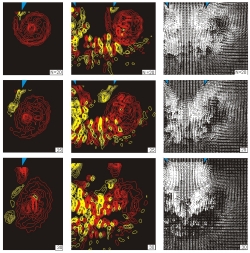You are here
Home ›Development of a Vortex System in Shallow Water: Near-Surface Flow Structure
Development of a vortex system in shallow water: near-surface flow structure. In the preceding two layouts, patterns of instantaneous velocity and vorticity above the surface were of primary interest. Those features of the flow structure have important consequences for the very near-surface region. In the above layout of images, the left column shows patterns of instantaneous vorticity viewed in a laser sheet located at mid-depth of the shallow water, i.e., at hL* = hL/W = 0.25 for a dimensionless water depth hw* = hw/W = 0.5, where W is the jet nozzle width. These vorticity distributions show highly concentrated regions of positive (thick white line) vorticity width within the center of the vortex, as well as negative vorticity (thin white line), which originates from the exterior of the nozzle. In the middle and right columns of images, patterns of vorticity and velocity are shown for a laser sheet located at an elevation hL* = hL/W = 0.03 above the bottom surface. Considering, first of all, the middle column of images at N = 20 and 25, the footprint of the primary, large-scale vortex evident at the mid-plane is clearly discernible. In addition, however, highly concentrated, small-scale regions of vorticity are evident. These concentrations exhibit alternating sign. At N = 30, the near-surface pattern of vorticity is dominated by these small-scale concentrations, and the primary, large-scale concentration is no longer distinguishable . The corresponding patterns of instantaneous velocity shown in the right column exhibit very large, abrupt gradients, especially along the leading-edge of the jet-like flow. Minimum and incremental values of vorticity are both 2 sec-1 for all images.

An impulsively-started jet in shallow water gives rise to vortices having a characteristic diameter larger than the water depth. A technique of high-image-density particle image velocimetry allows characterization of the space-time development of the instantaneous flow patterns along planes representing the quasi-two-dimensional and three-dimensional vortex structure. The quasi-two-dimensional patterns exhibit different categories of vortex development and interaction, depending upon the depth of the shallow water layer.
These quasi-two-dimensional patterns are, in turn, related to specific forms of three-dimensional flow structure, which is highly-ordered. A prevalent feature is a vortex orthogonal to, and just ahead of, the primary, quasi-two-dimensional vortex. Its streamline topology, on a plane parallel to the axis of the quasi-two-dimensional vortex, exhibits a separation bubble with a well-defined separatix at the bottom (bed) surface. Moreover, its value of vorticity can exceed that of the quasi-two-dimensional pattern by a factor of two. This feature is consistent for all values of water depth. When the depth becomes sufficiently large, however, the three-dimensional vortex pattern involves an array of vorticity concentrations, which extend across the entire depth of the water.
On a plane very close to the bottom surface (bed), global, instantaneous distributions of velocity and vorticity exhibit large gradients; they are associated with small-scale vorticity concentrations. The corresponding streamline topology of the averaged flow close to the bed, however, exhibits a stable focus and is a direct indicator of the topology well above the bed.
